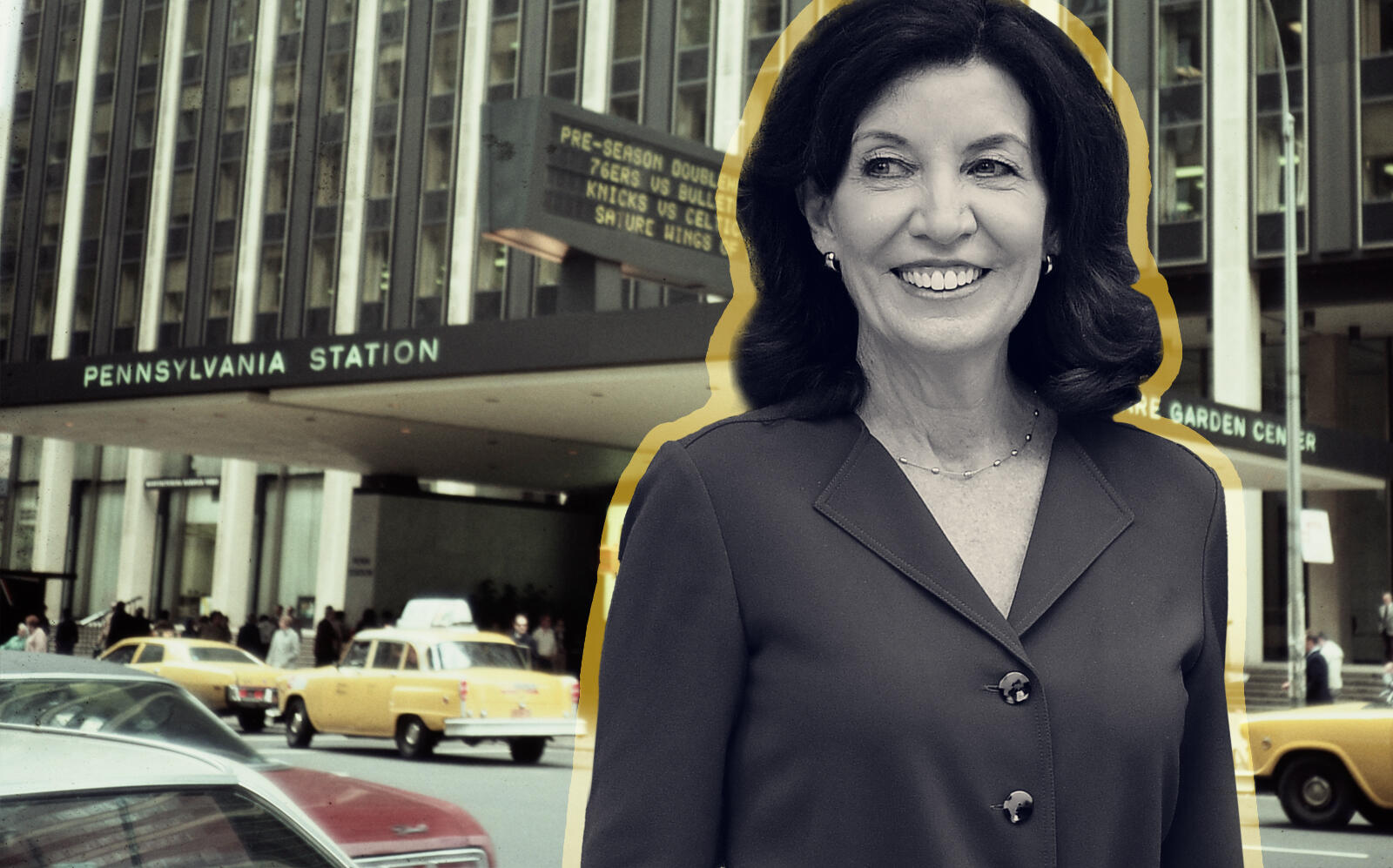Gov. Kathy Hochul is suspending plans to expand Penn Station and will instead redevelop the reviled transit hub, while still paving the way for commercial development that would exceed Hudson Yards in scope.
Hochul on Wednesday afternoon announced a scaled-down version of a plan by her predecessor, Andrew Cuomo, for 10 new towers and a terminal to the south of Penn.
The state is moving forward with plans for the buildings, which would be built on sites mostly controlled by Vornado Realty Trust. But it is diverting its attention away, for now, from the new terminal, which requires the demolition of 50-plus properties on West 31st Street to make way for eight new tracks. The governor indicated that those properties will still need to be acquired when the the state moves forward with the expansion. Eight new tracks are planned to the south of the station and would connect to the long-delayed Gateway Tunnel.
Hochul’s plan trims the planned development by 1.4 million square feet, a 7 percent reduction. The uses will still mostly be commercial, but the plan includes 1,800 residential units, with 540 affordable, an option that the state had been considering before Cuomo stepped down. The New York Times was the first to report details on the governor’s plans.
The announcement follows months of uncertainty over whether Hochul would pursue Cuomo’s vision for the station. She had repeatedly described the transit hub as “scary” and vowed to improve it, but had signaled that she would scale back the proposal, which included buying more than $1 billion worth of real estate on West 31st Street to build the terminal. She had already pumped the brakes on another Cuomo project, the LaGuardia AirTrain.
During a recent event, Hochul said she wanted to get “Penn Station itself redone,” echoing comments made by Metropolitan Transportation Authority acting chair Janno Lieber, who said in September that he was focused on the existing station, rather than expansion.
Scrapping the Penn project entirely would have alienated construction labor unions as well as some of the biggest political donors in New York real estate. Hochul is already facing fierce competition in the June Democratic primary: Attorney General Letitia James announced her candidacy last week, and Public Advocate Jumaane Williams and Mayor Bill de Blasio have filed paperwork to run. As Cuomo’s former lieutenant governor, Hochul is trying to distance herself from the disgraced governor, but also needs to court some of his former supporters.
Cuomo’s plan drew the ire of elected officials and community members, who complained that the commercial development would circumvent local zoning rules and do little to improve Penn Station.
The state’s last budget included $1.3 billion for the project, though direct use of the funds for the towers was prohibited by legislators. The budget language, however, allowed for the money to go toward acquiring the properties south of the station.
Hochul is moving forward on Penn as New York and New Jersey await the construction of two train tunnels under the Hudson River. Penn’s overhaul would cost about $6 to 7 billion and remove Penn’s upper level to allow more natural light into the station. The governor said roughly $1.5 billion of that cost is expected to be generated from the development surrounding the station.
The new plan also includes eight acres of public space and a new pedestrian underground passageway connecting Seventh Avenue and Herald Square, formerly known as the Gimbels Corridor. Hochul also noted that she’d like to change Penn Station’s name.
Samuel Turvey, chairperson of ReThink Penn Station, commended Hochul for scaling back the project, but lamented that she is not relocating Madison Square Garden nor ruling out expansion in favor of transforming Penn into a through-station so trains need not turn around there.
“To spend $7 billion to keep Penn Station under Madison Square Garden and to expand this underground to add more and unnecessary tracks defies logic,” Turvey said in an email, reacting to the initial news of the governor’s plans. “While every effort will be made to make this work, as has been done in the past, you cannot repair this fundamental flaw unless Madison Square Garden moves and a real, above-ground train station is built.”
The Garden’s permit expires in 2023, but no apparent effort has been made to find a new location for the arena.
Cuomo envisioned a broader district, dubbed “Midtown West,” that would ultimately include more than 20 million square feet of new development, eclipsing nearby Hudson Yards in scale.
The plan included two state-owned sites near the Javits Center, where up to 838 affordable apartments could be built. Empire State Development officials indicated in July that they were contemplating another 1,800 residential units on three sites near Penn, where 540 apartments would be affordable.
During Vornado’s earnings call Tuesday, CEO Steven Roth said he was “very, very optimistic” about state leaders’ plans for the district. Vornado has amassed more than 9 million square feet in the vicinity of Penn Station and has long envisioned transforming the district into an office campus.
